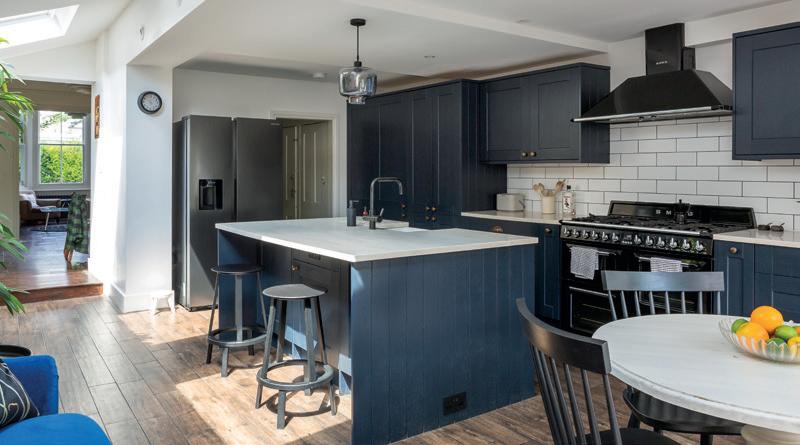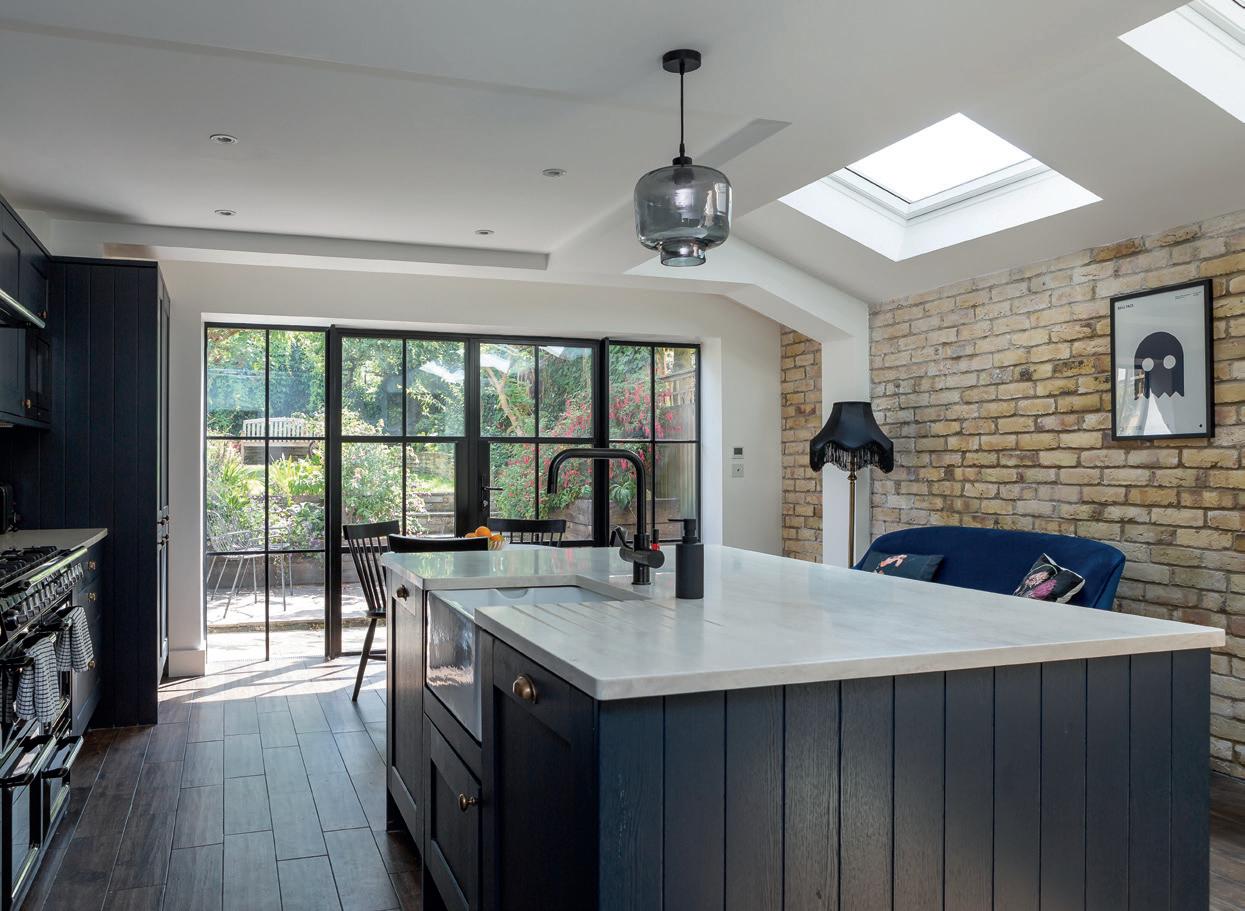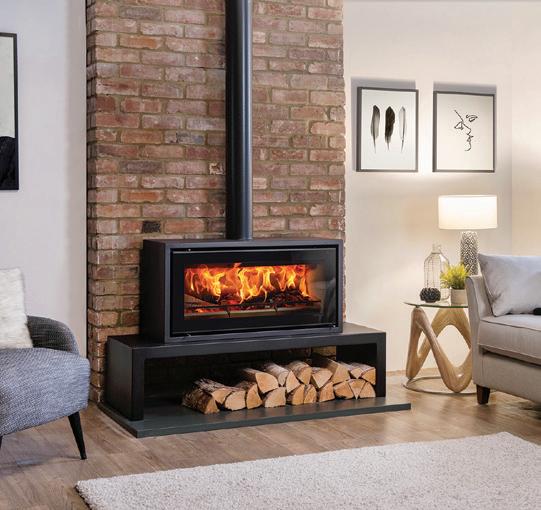
13 minute read
Urban Sanctuary
Cooking up a storm
After 12 years of living in their late-Victorian East Dulwich home, husband and wife Paul and Lindsay Davies were forced to admit that their kitchen was no longer fit for purpose. With little room to appreciate the heart of their home and difficult spaces in general, the pair turned to Plus Rooms for help.
Advertisement

As a specialist in improving and enlarging residential properties, Plus Rooms has addressed the Davies’ spatial and aesthetic issues, improving the natural flow of the ground floor and increasing sought-after daylighting with an extension that complements the character of the original house with an eye-catching, striking design. Here, i-Build Editor, Rebecca Kemp, talks to Lindsay about the stunning transformation and finds out more about the space the couple lived in for over a decade before deciding to take the home improvement route.
RK: Tell us why you decided to take on this project?
LD: All our cupboards were full to bursting, we had no work surface space, and the garden entrance was poky and awkward. The side return had become a dumping ground and was being used as a collective litter tray by all the neighbourhood’s cats! To top it off, every kitchen appliance seemed to break at once, so we had to replace them all anyway. It felt like a sign.

RK: How did you combine the original building’s style with the extension?
LD: Externally, we kept the same style of brickwork, using modern ‘aged’ reproductions of old London stock bricks which look virtually indistinguishable from the originals. Inside, we wanted to open up the back part of our living room so that it flowed through to the kitchen. We extended the floorboards and stained them, so it looked seamless.
RK: What was your vision and inspiration?
LD: We had a Pinterest board that changed over time – we started off wanting to replicate our original kitchen (which had quite a ‘cottagey’ vibe), but we kept finding ourselves drawn to more dramatic, darker colours. We found a black freestanding cabinet we liked, and the rest of the kitchen’s look followed on from that.

RK: How long did it take to gain planning permission?
LD: It did take a while, though I don’t remember exactly how long. Plus Rooms guided us through the whole process.
RK: Were there any challenging aspects to the project and build?
LD: The most challenging thing was living and working at home while it was all going on. I’m a Book Editor, and I work from home most of the time, so there was no getting away from the noise and chaos. The builders did a good job trying to protect the rest of the house. However, it was still very challenging spending three months cooking on a little two-ring electric stove balanced on top of a makeshift work surface in our living room, with all of our stored food covered in a layer of dust! In terms of the actual build, the hardest thing was getting the huge steel beams through the house. I thought the builders were going to have to saw our bannisters off at one point or dismantle our original Victorian sash window in the living room (over my dead body!). Luckily, they managed to get them in, but that was a hugely stressful moment.
RK: Why did you choose to work with Plus Rooms?
LD: Two of our friends had done kitchen extensions with Plus Rooms, so we knew they were good. Both friends had used a particular build team, so we requested to have the exact same one – we waited until they were free as we wanted to go with a team that had been personally recommended. We liked the fact that Plus Rooms assigned a project co-ordinator to oversee the project, so we had someone with technical knowledge we could go to if we had any problems.
RK: How long did the project take?
LD: The main build was pretty much completed to timeframe – eight or nine weeks if I remember rightly. We started on 1st April 2019, and we were in by July. But there’s always a ‘long tail’ of little jobs at the




end of any build, so I think we still had people coming in to finish bits and pieces in August and even September.
RK: Did you remain within the original budget?
LD: We deliberately overbudgeted for everything and had a contingency built in, so we were technically within budget. Still, we spent an eyewatering amount! The basic build was what we were initially quoted (£43,800), but there were lots of extras, e.g. £2k for removing a chimney breast, £3800 to raise the steels into the ceiling, £7k for the doors/windows etc. The main building costs, including a party wall surveyor, fees, plumbing and electrics, new boiler etc. came to just over £75k. Then there was the cost of the finishing team and all the fixtures and fittings on top.
RK: How does the extension respond to the landscape?
LD: I’m thrilled that we’ve managed to make accessing the back garden much easier. It’s a cliche, but it really has opened it up and brought the outside inside. I’ve had so much pleasure sitting and looking out over the garden over the last year.
RK: Is the finished space everything that you hoped it would be?
LD: Yes. It’s quite a pressure to design your ‘dream kitchen’ from scratch, having never done it before, but we’d spent a lot of time planning it, and in the end, it was exactly what we wanted. I don’t think there’s anything I would change.
RK: Have you found a change in the way you use your kitchen?
LD: We all spend so much more time in it. It’s a much more sociable space. And it’s been a lifesaver during lockdown as my husband has been using it as his base to work from home.
RK: What do you love most about it?
LD: Sitting on the sofa in the morning with a coffee, looking out at the garden and having a few minutes of quiet before the day starts. That was the image in my mind that kept me going throughout the difficult times in the build. You literally couldn’t see the garden from our old kitchen unless you were standing at the sink; now it’s always in our sight-line, and I get so much pleasure from it.
RK: Is there anything that you would have done differently?
LD: We spent a lot of time discussing the height of the floor with the builders, but somehow we still managed to get it wrong, and they had to cut down some doors in the hall as a result. I still don’t quite understand how that happened. But it wasn’t the end of the world.
RK: Would you do the whole thing again?
LD: Not in any hurry, thank you! I’m very happy to take some time to enjoy what we’ve got. That said, I’m delighted we did it, so no regrets on that score.
RK: What advice would you offer to anyone looking to renovate?
LD: Go with people who are recommended to you personally. Having a good build team and project manager made all the difference to us. Also, it’s worth micro-planning how you’re going to use your kitchen. We spent ages figuring out exactly how we wanted to arrange the cupboards, where we would stand when emptying the dishwasher, what our view would be when we were sitting on the sofa etc. and drawing out different configurations of how the kitchen would be laid out until we got it right. Where will the cling film go? Where will the cat’s food bowl live? Is there enough space to get past easily if the dishwasher is open? It’s all that attention to detail that’s paid off in how we use the kitchen now.



10
elements to consider when choosing a stove or fire
Are you renovating your fireplace and about to start your journey towards a new stove or fire? Annabelle Carvell, PR Officer at the Stovax Heating Group, offers her top 10 points to consider to help you understand your requirements.
1. What fuel type are you looking for?
One of your first considerations is likely to be the fuel type you are looking for. Are you set on a real woodburning stove, with authentic flames from log burning, or perhaps you are drawn to the convenience of gas? On the other hand, electric heat offers an entirely different aesthetic and lends itself admirably to well-insulated properties. Deciding your fuel type early on may help you work out more about your project, and will also assist with budgeting for the work required for your unique needs.
2. What’s your style?
Today’s stoves and fires come in a host of different shapes and sizes, from inset industrial-chic woodburners, such as the Vogue 700 Inset from Stovax, to tall, Scandi-inspired freestanding models like the Loft from Gazco. Whatever your home interior, there is likely to be a style to suit.
3. Do you have a chimney?
Woodburning fires and stoves need a chimney or flue system to operate. Likewise, conventional flue gas fires also need a flue for the combustion gases to escape. If you do not have a chimney but are set on a woodburner or gas log burner, there are options available to you – depending on the level of budget and work you are happy to carry out. If you don’t have a chimney, you may be able to have a pre-fabricated one installed that works in the same way as a standard chimney. There are options for you to have a chimney system that either runs internally or externally to your property, allowing you to enjoy a woodburning stove or conventional flue gas fire in your home. Alternatively, many gas fires and stoves come as balanced flue versions which allow for a chimneyless installation, using a twin-wall pipe to vent directly through an exterior wall. For complete ease of installation, electric stoves and fires do not require a chimney at all and can be simply plugged into the mains to function.


4. Understand smoke control areas
If you live in a town or city, you likely live in a Smoke Control Area. To meet the smoke emission standards for these areas, you can only burn authorised smokeless fuels on a multi-fuel appliance – a list of which can be found by visiting the DEFRA website. If you want to burn wood, your appliance must be suitable for use in Smoke Control Areas, which you can find on your manufacturer’s product information.
5. Check the latest regulations
The latest regulation you may have heard of is the Ecodesign directive. While this does not affect you as a consumer, it may help you make a more environmentallyconsidered choice when looking at woodburning or multifuel stoves and fires.
Ecodesign will become law for solid fuel stove manufacturers from 2022, requiring them to adhere to stringent emissions rules, helping to improve air quality. Ecodesign Ready stoves and fires reduce emissions significantly compared to older models, so it is worth keeping this in mind when looking at solid fuel appliances.
6. What heat output do you need for your home?
Your installer and retailer will be able to help best with determining the heat output you need, as factors such as the windows and age of the house can all affect the outcome. As a rough guideline, to achieve a relaxing room temperature of around 21ºC when the air outside your house is at freezing (0ºC) you will need approximately 1kW of heat output for every 14m3 of space. Measure the length, width and height of your room and multiply the three figures together – and then divide the sum by 14 for a guideline.
7. Choose a professional for installation
Installation of your stove or fire, be it woodburning or gas, is a job for the professionals. You can generally install electric appliances with ease by simply placing in the space desired, but some more elaborate installations – like TV media walls – can involve a fitter. When installing a stove or fire, safety standards are paramount, so we would always recommend getting your product installed by a qualified installer, whether that is by HETAS if installing wood or solid fuel products, or Gas Safe if installing a gas product. The installation will need to meet the minimum hearth, distance to combustibles and ventilation requirements, and comply with local building control rules.
8. Get to grips with maintenance
A solid fuel stove requires an annual service, including stripping and cleaning the appliance thoroughly and removing all excess ash. It will also need to be checked for any broken or damaged parts that need replacing, and the door glass will need cleaning. Like your stove, your chimney also requires maintenance, as along with obstructions, deposits and tar can build-up in your chimney over time, reducing the draw, making the stove run less efficiently and putting your property at risk of a chimney fire. If you are burning wood, ensure your chimney is swept at least twice a year; this can be reduced to once if you are using a multi-fuel stove to burn fuels other than wood. It is also essential to have your stove serviced by a qualified installer to ensure you see the best performance from your appliance. A gas fire will also need servicing and its glass door cleaning – it is possible to clean the glass yourself, following instructions supplied with the product. It is recommended that gas appliances are safety checked and serviced at least once a year by a registered gas service engineer. Maintenance of an electric fire is easy and straightforward. It usually just involves dusting and cleaning the fuel effects, plus any accessible air inlets and outlets to maintain the optimum heat output and efficiency from the fire.
9. If burning wood, burn right
If you opt for a new and efficient woodburner, it is worth looking after your investment by feeding it the right fuel. Poor-quality wood tends to have a high moisture content. When wet wood is burnt, such as freshly felled timber, a large amount of the heat energy created by the fire is wasted burning off the excess water, resulting in poor combustion. Aside from wasting energy, burning wet wood results in tars and creosote production, which can damage a flue and increase the risk of chimney fires.
10. Shop local
Shopping local is more and more at the forefront of our minds, but aside from supporting your local economy, visiting your local retailer has many further benefits. They can help you to choose the best options for your home by demonstrating live burning products and offering advice, alongside arranging site surveys, recommending installers or even offering bespoke installation packages. Additionally, your local retailer can provide aftersales support, servicing, often enabling you to extend your manufacturer’s warranty – all helping you to take the very best care of your new home investment.








